Geochronological Study of the Jiashengpan Zn–Pb Deposit in Northern China: Implications for Base Metal Mineralization in Collisional Orogens
Abstract
1. Introduction
2. Regional Geology
3. Geology of Jiashengpan Deposit
4. Materials and Methods
4.1. Muscovite 39Ar/40Ar Dating
4.2. Zircon U–Pb Dating
5. Results
6. Discussion
7. Conclusions
Author Contributions
Funding
Acknowledgments
Conflicts of Interest
References
- Lang, D.Y.; Zhang, X.J. Geological setting and genesis of the Jiashengpan Pb–Zn–S ore belt, Inner Mongolia. Miner. Depos. 1987, 6, 39–54, (in Chinese with English abstract). [Google Scholar]
- Peng, R.M.; Zhai, Y.S.; Wang, Z.G. Ore-controlling synchronous faults of Mesoproterozoic Dongshengmiao and Jiashengpan SEDEX-type ore deposits, Inner Mongolia. Earth Sci. 2000, 25, 404–410, (in Chinese with English abstract). [Google Scholar]
- Peng, R.M.; Zhai, Y.S. The characteristics of hydrothermal exhalative mineralization of the Langshan—Zhaertai belt, Inner Monogolia, China. Geosci. Front. 2004, 11, 257–268, (in Chinese with English abstract). [Google Scholar]
- Fu, C. The Geological Features and Genesis of the Jiashengpan Lead–Zinc Deposit in Inner Mongolia, China. Master’s Thesis, China University of Geosciences, Beijing, China, 2010. [Google Scholar]
- Niu, S.Y.; Hu, X.; Xu, C.S. Geological features of ductile shear zone of chaertai group in Inner Mongolia. J. Hebei Geo Univ. 1990, 2, 147–156, (in Chinese with English abstract). [Google Scholar]
- Zhong, R.C. The Potential of Forming Cu–Pb–Zn Deposits during Regional Metamorphism: Thermodynamic Modelling and a Case Study on the Langshan-Zhaertai Metallogenic Belt. Ph.D. Thesis, Peking University, Beijing, China, 2014. [Google Scholar]
- Chen, Y.J. Orogenic-type deposit and their metallogenic model and exploration potential. Chin. Geol. 2006, 33, 1181–1196, (in Chinese with English abstract). [Google Scholar]
- Pirajno, F. Hydrothermal Processes and Mineral Systems, 1st ed.; Springer: Berlin, Germany, 2009; pp. 1–1250. [Google Scholar]
- Zheng, Y.; Zhang, L.; Chen, Y.J.; Hollings, P.; Chen, H.Y. Metamorphosed Pb–Zn–(Ag) ores of the Keketale VMS deposit, NW China: Evidence from ore textures, fluid inclusions, geochronology and pyrite compositions. Ore Geol. Rev. 2013, 54, 167–180. [Google Scholar] [CrossRef]
- Phillips, G.N.; Powell, R. Formation of gold deposits: A metamorphic devolatilization model. J. Metamorph. Geol. 2010, 28, 689–718. [Google Scholar] [CrossRef]
- Zhong, R.C.; Brugger, J.; Chen, Y.J.; Li, W.B. Contrasting regimes of Cu, Zn and Pb transport in ore-forming hydrothermal fluids. Chem. Geol. 2015, 395, 154–164. [Google Scholar] [CrossRef]
- Peng, R.M.; Zhai, Y.S.; Han, X.F.; Wang, Z.G.; Wang, J.P.; Liu, J.J. Sinsedimentry volcanic activities in the cracking process of the Mesoproterozoic aulacogen of passive continental margin in Langshan-Zhaertai area, Inner Mongolia, and its indicating significance. Acta Petrol. Sin. 2007, 23, 1007–1017, (in Chinese with English abstract). [Google Scholar]
- Peng, R.M.; Zhai, Y.S.; Wang, J.P.; Chen, X.F.; Liu, Q.; L, J.Y.; Shi, Y.X.; Wang, G.; Li, S.B.; Wang, L.G.; et al. Discovery of Neoproterozoic acid volcanic rock in the south-western section of Langshan, Inner Mongolia. Chin. Sci. Bull. 2010, 55, 2611–2620, (in Chinese with English abstract). [Google Scholar]
- Gong, W.B.; Hu, J.M.; Li, Z.H.; Dong, X.P.; Liu, S.C. Detrital zircon U–Pb dating of Zhaertai Group in the North Margin Rift Zone of North China Craton and its implications. Acta Petrol. Sin. 2016, 32, 2151–2165, (in Chinese with English abstract). [Google Scholar]
- Li, Q.L.; Chen, F.K.; Guo, J.H.; Li, X.H.; Yang, Y.H.; Siebel, W. Zircon ages and Nd–Hf isotopic composition of the Zhaertai Group (Inner Mongolia): Evidence for early Proterozoic evolution of the northern North China Craton. J. Asian Earth Sci. 2007, 30, 573–590. [Google Scholar] [CrossRef]
- Hu, J.M.; Gong, W.B.; Wu, S.J.; Liu, Y.; Liu, S.C. LA-ICP-MS zircon U–Pb dating of the Langshan Group in the northeast margin of the Alxa block, with tectonic implications. Precambrian Res. 2014, 255, 756–770. [Google Scholar] [CrossRef]
- Pi, Q.H.; Liu, C.Z.; Chen, Y.L.; Li, Y.Q.; Li, D.P. Formation epoch and genesis of intrusive rocks in Huogeqi orefield of Inner Mongolia and their relationship with copper mineralisation. Miner. Depos. 2010, 29, 437–451, (in Chinese with English abstract). [Google Scholar]
- Liu, Y. Geochemical and Chronological Characteristics of the Granitic Gneisses and Intrusive Rocks from Dongshengmiao Ore District, Inner Mongolia and their Tectonic Implications. Master’s Thesis, Lanzhou University, Lanzhou, China, 2012. [Google Scholar]
- Wu, Y.F.; Zeng, J.N.; Cao, J.J.; Wu, Z.Q.; Chen, J.H.; Zhou, S.D.; Lu, S.F.; Li, X.F. Zircon U-Pb ages an Hf isotopes of Hercynia intrusion in Dongshengmiao, Inner Mongolia. Geol. Sci. Technol. Inf. 2013, 32, 22–30, (in Chinese with English abstract). [Google Scholar]
- Hu, C.S.; Li, W.B.; Xu, C.; Zhong, R.C.; Zhu, F.; Qiao, X.Y. Geochemistry and petrogenesis of Permian granitoids in the northwestern margin of the North China Craton: Insights from the Dongshengmiao pluton, Inner Mongolia. Int. Geol. Rev. 2015, 57, 1843–1860. [Google Scholar] [CrossRef]
- Qiao, X.Y.; Li, W.B.; Zhong, R.C.; Hu, C.S.; Zhu, F.; Li, Z.H. Elemental and Sr-Nd isotopic geochemistry of the Uradzhongqi magmatic complex in western Inner Mongolia, China: A record of early Permian post-collisional magmatism. J. Asian Earth Sci. 2017, 144, 171–183. [Google Scholar] [CrossRef]
- Zhao, P.; Xu, B.; Zhang, C.H. A rift system in southeastern Central Asian Orogenic Belt: Constraint from sedimentological, geochronological and geochemical investigations of the Late Carboniferous-Early Permian strata in northern Inner Mongolia (China). Gondwana Res. 2017, 47, 342–357. [Google Scholar] [CrossRef]
- Xiao, W.J.; Windley, B.F.; Hao, J.; Zhai, M.G. Accretion leading to collision and the Permian Solonker suture, Inner Mongolia, China: Termination of the central Asian orogenic belt. Tectonics 2003, 22. [Google Scholar] [CrossRef]
- Xiao, W.J.; Windley, B.F.; Huang, B.C.; Han, C.M.; Yuan, C.; Chen, H.L.; Sun, M.; Sun, S.; Li, J.L. End-Permian to mid-Triassic termination of the accretionary processes of the southern Altaids: Implications for the geodynamic evolution, Phanerozoic continental growth, and metallogeny of Central Asia. Int. J. Earth Sci. 2009, 98, 1219–1220. [Google Scholar] [CrossRef]
- Zhang, S.H.; Zhao, Y.; Song, B.; Hu, J.M.; Liu, S.W.; Yang, Y.H.; Chen, F.K.; Liu, X.M.; Liu, J. Contrasting Late Carboniferous and Late Permian—Middle Triassic intrusive suites from the northern margin of the North China craton: Geochronology, petrogenesis, and tectonic implications. Geol. Soc. Am. Bull. 2009, 121, 181–200. [Google Scholar] [CrossRef]
- Xu, B.; Charvet, J.; Chen, Y.; Zhao, P.; Shi, G.Z. Middle Paleozoic convergent orogenic belts in western Inner Mongolia (China): Framework, kinematics, geochronology and implications for tectonic evolution of the Central Asian Orogenic Belt. Gondwana Res. 2013, 23, 1342–1364. [Google Scholar] [CrossRef]
- Xu, B.; Zhao, P.; Bao, Q.Z.; Zhou, Y.H.; Wang, Y.Y.; Luo, Z.W. Preliminary study on the pre-Mesozoic tectonic unit division of the Xing-Meng Orogenic Belt (XMOB). Acta Petrol. Sin. 2014, 30, 1841–1857, (in Chinese with English abstract). [Google Scholar]
- Shao, J.A.; Tang, K.D.; He, G.Q. Early Permian tectono-palaeogeographic reconstruction of Inner Mongolia, China. Acta Petrol. Sin. 2014, 30, 1858–1866, (in Chinese with English abstract). [Google Scholar]
- Shao, J.A.; He, G.Q.; Tang, K.D. The evolution of Permian continental crust in northern part of North China. Acta Petrol. Sin. 2015, 31, 47–55, (in Chinese with English abstract). [Google Scholar]
- Jian, P.; Liu, D.Y.; Kroner, A.; Windley, B.F.; Shi, Y.R.; Zhang, W.; Zhang, F.Q.; Miao, L.C.; Zhang, L.Q.; Tomurhuu, D. Evolution of a Permian intraoceanic arc-trench system in the Solonker suture zone, Central Asian Orogenic Belt, China and Mongolia. Lithos 2010, 118, 169–190. [Google Scholar] [CrossRef]
- Chen, Y.P.; Wei, C.J.; Zhang, J.R.; Chu, H. Metamorphism and zircon U–Pb dating of garnet amphibolite in the Baoyintu Group, Inner Mongolia. Sci. Bull. 2015, 60, 1698–1707. [Google Scholar] [CrossRef]
- Chu, H.; Zhang, J.R.; Wei, C.J.; Wang, H.C.; Ren, Y.W. A new interpretation of the tectonic setting and age of meta-basic volcanics in the Ondor Sum Group, Inner Mongolia. Chin. Sci. Bull. 2013, 58, 3580–3587, (in Chinese with English abstract). [Google Scholar] [CrossRef]
- Zhang, J.R.; Chu, H.; Wei, C.J.; Wang, K. Geochemical characteristics and tectonic significance of Late Paleozoic-Early Mesozoic meta-basic rocks in the melange zones, Central Inner Mongolia. Acta Petrol. Sin. 2014, 30, 1935–1947, (in Chinese with English abstract). [Google Scholar]
- Song, S.G.; Wang, M.M.; Xu, X.; Wang, C.; Niu, Y.L.; Allen, M.B.; Su, L. Ophiolites in the Xing’an-Inner Mongolia accretionary belt of the CAOB: Implications for two cycles of seafloor spreading and accretionary orogenic events. Tectonics 2015, 34, 2221–2248. [Google Scholar] [CrossRef]
- Zhang, J.R.; Wei, C.J.; Chu, H. New model for the tectonic evolution of Xing’an-Inner Mongolia Orogenic Belt: Evidence from four different phases of metamorphism in Central Inner Mongolia. Acta Petrol. Sin. 2018, 34, 2857–2872, (in Chinese with English abstract). [Google Scholar]
- Baksi, A.K.; Archibald, D.A.; Farrar, E. Use of a double-spike to determine the half-life of 39Ar and the operating characteristics of a mass spectrometer used in geochronological studies. Can. J. Phys. 1996, 74, 263–266. [Google Scholar] [CrossRef]
- Koppers, A.A.P. ArArCALC-software for 40Ar/39Ar age calculations. Comput. Geosci. 2002, 28, 605–619. [Google Scholar] [CrossRef]
- Dalrymple, G.B.; Lanphere, M.A. 40Ar/39Ar technique of K–Ar dating: A comparison with the conventional technique. Earth Planet. Sci. Lett. 1971, 12, 300–308. [Google Scholar] [CrossRef]
- Fleck, R.J.; Sutter, J.F.; Elliott, D.H. Interpretation of discordant 40Ar/39Ar age-spectra of Mesozoic tholeiites from Antarctica. Geochim. Cosmochim. Acta 1977, 41, 15–32. [Google Scholar] [CrossRef]
- Yuan, H.; Gao, S.; Liu, X.; Li, H.; Günther, D.; Wu, F. Accurate U–Pb age and trace element determinations of zircon by laser ablation-inductively coupled plasma-mass spectrometry. Geostand. Geoanal Res. 2004, 28, 353–370. [Google Scholar] [CrossRef]
- Andersen, T. Correction of common lead in U–Pb analyses that do not report 204Pb. Chem. Geol. 2002, 192, 59–79. [Google Scholar] [CrossRef]
- Liu, Y.S.; Gao, S.; Hu, Z.C.; Gao, C.G.; Zong, K.Q.; Wang, D.B. Continental and oceanic crust recycling-induced melt-peridotite interactions in the trans-north China orogen: U–Pb dating, Hf Isotopes and trace elements in zircons from mantle xenoliths. J. Petrol. 2010, 51, 537–571. [Google Scholar] [CrossRef]
- Ludwig, K. User′s manual for IsoPlot 3.0. In A Geochronological Toolkit for Microsoft Excel; Berkeley Geochronology Center: Berkeley, CA, USA, 2003; p. 71. [Google Scholar]
- McDougall, I.; Mac Dougall, I.; Harrison, T.M. Geochronology and Thermochronology by the 40Ar/39Ar Method, 2nd ed.; Oxford University: Oxford, UK, 1999; pp. 1–269. [Google Scholar]
- Belousova, E.A.; Griffin, W.L.; O′Reilly, S.Y.; Fisher, N.I. Igneous zircon: Trace element composition as an indicator of source rock type. Contrib. Mineral. Petrol. 2002, 143, 602–622. [Google Scholar] [CrossRef]
- Goldfarb, R.; Baker, T.; Dube, B.; Groves, D.I.; Hart, C.J.; Gosselin, P. Distribution, character and genesis of gold deposits in metamorphic terranes. Econ. Geol. 2005, 2005, 407–450. [Google Scholar]
- Goldfarb, R.J.; Groves, D.I.; Gardoll, S. Orogenic gold and geologic time: A global synthesis. Ore. Geol. Rev. 2001, 18, 1–75. [Google Scholar] [CrossRef]
- Hart, C.J.R.; Goldfarb, R.J.; Qiu, Y.M.; Snee, L.; Miller, L.D.; Miller, M.L. Gold deposits of the northern margin of the North China Craton: Multiple late Paleozoic-Mesozoic mineralizing events. Miner. Depos. 2002, 37, 326–351. [Google Scholar] [CrossRef]
- Miao, L.C.; Qiu, Y.M.; McNaughton, N.; Fan, W.M.; Groves, D.I.; Zhai, M.G. SHRIMP U-Pb zircon ages of granitoids in the Wulashan gold deposit, inner Mongolia, China: Timing of mineralization and tectonic implications. Int. Geol. Rev. 2003, 45, 548–562. [Google Scholar] [CrossRef]
- Pitcairn, I.K.; Teagle, D.A.H.; Craw, D.; Olivo, G.R.; Kerrich, R.; Brewer, T.S. Sources of metals and fluids in orogenic gold deposits: Insights from the Otago and Alpine schists, New Zealand. Econ. Geol. 2006, 101, 1525–1546. [Google Scholar] [CrossRef]
- Marshall, B.; Vokes, F.M.; Larocque, A.C.L. Regional metamorphic remobilisation: Upgrading and formation of ore deposits. Rev. Econ. Geol. 2000, 11, 19–38. [Google Scholar]
- Leach, D.L.; Landis, G.P.; Hofstra, A.H. Metamorphic origin of the Coeur d’Alene base-and precious-metal veins in the Belt basin, Idaho and Montana. Geology 1988, 16, 122–125. [Google Scholar] [CrossRef]
- Zheng, Y.; Wang, Y.J.; Chen, H.Y.; Lin, Z.W.; Hou, W.S.; Li, D.F. Micro-textural and fluid inclusion data constraints on metallic remobilization of the Ashele VMS Cu–Zn deposit, Altay, NW China. J. Geochem. Explor. 2016, 171, 113–123. [Google Scholar] [CrossRef]
- Zhang, H.; Xu, J.H.; Guo, X.J.; Xiao, X.; Un, L.H.; Yang, R.; Cheng, X.H. Metamorphic overprints on the Talate Pb–Zn deposit in Altay: Evidences from geology and fluid inclusions. Acta Petrol. Sin. 2015, 31, 1063–1078. [Google Scholar]
- Moura, A. Metamorphosed and metamorphogenic ores of the Neves Corvo volcanogenic massive sulfide deposit, Iberian Pyrite Belt, Portugal. Int. Geol. Rev. 2008, 50, 89–96. [Google Scholar] [CrossRef]
- Marignac, C.; Diagana, B.; Cathelineau, M.; Boiron, M.C.; Banks, D.; Fourcade, S.; Vallance, J. Remobilisation of base metals and gold by Variscan metamorphic fluids in the south Iberian pyrite belt: Evidence from the Tharsis VMS deposit. Chem. Geol. 2003, 194, 143–165. [Google Scholar] [CrossRef]
- Kampmann, T.C.; Jansson, N.J.; Stephens, M.B.; Olin, P.H.; Gilbert, S.; Wanhainen, C. Syn-tectonic sulphide remobilization and trace element redistribution at the Falun pyritic Zn–Pb–Cu–(Au–Ag) sulphide deposit, Bergslagen, Sweden. Ore Geol. Rev. 2018, 96, 48–71. [Google Scholar] [CrossRef]
- Li, W.B.; Chen, Y.J.; Lai, Y.; Ji, J.Q. Metallogenic time and tectonic setting of the Bainaimiao Cu–Au deposit, Inner Mongolia. Acta Petrol. Sin. 2008, 24, 890–898, (in Chinese with English abstract). [Google Scholar]
- Li, W.B.; Hu, C.S.; Zhong, R.C.; Zhu, F. U–Pb, 39Ar/40Ar geochronology of the metamorphosed volcanic rocks of the Bainaimiao Group in central Inner Mongolia and its implications for ore genesis and geodynamic setting. J. Asian Earth Sci. 2015, 97, 251–259. [Google Scholar] [CrossRef]
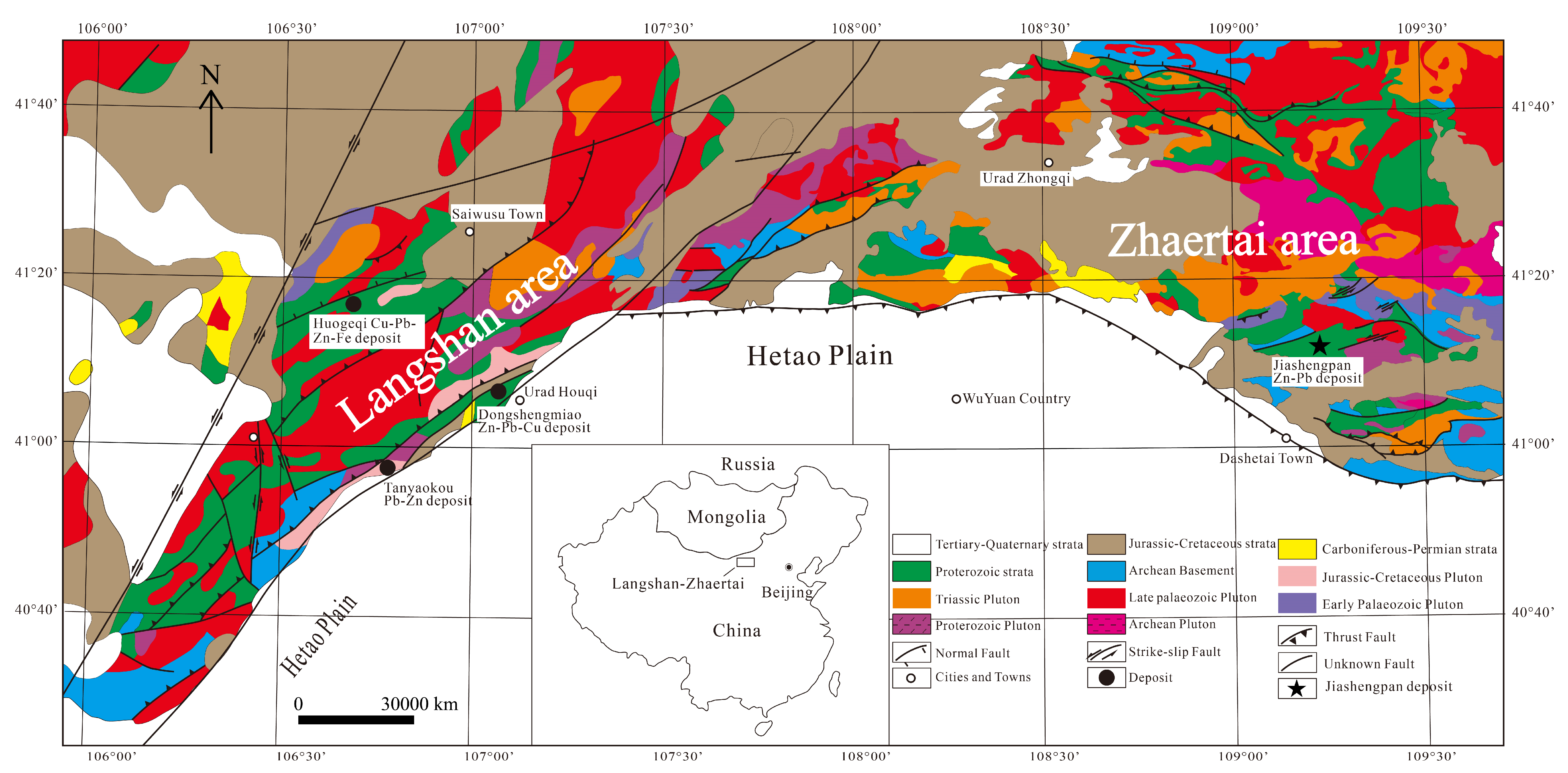
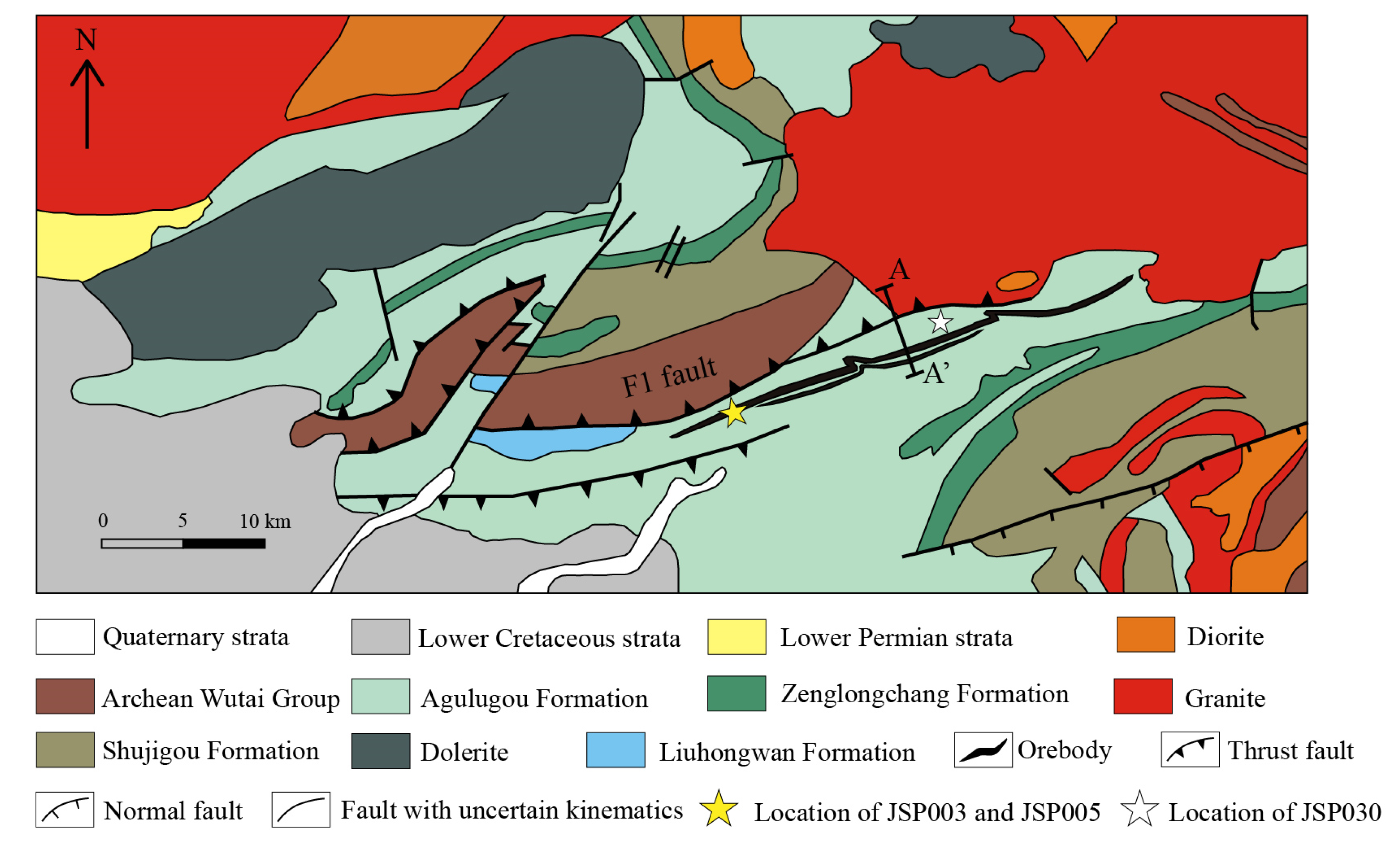
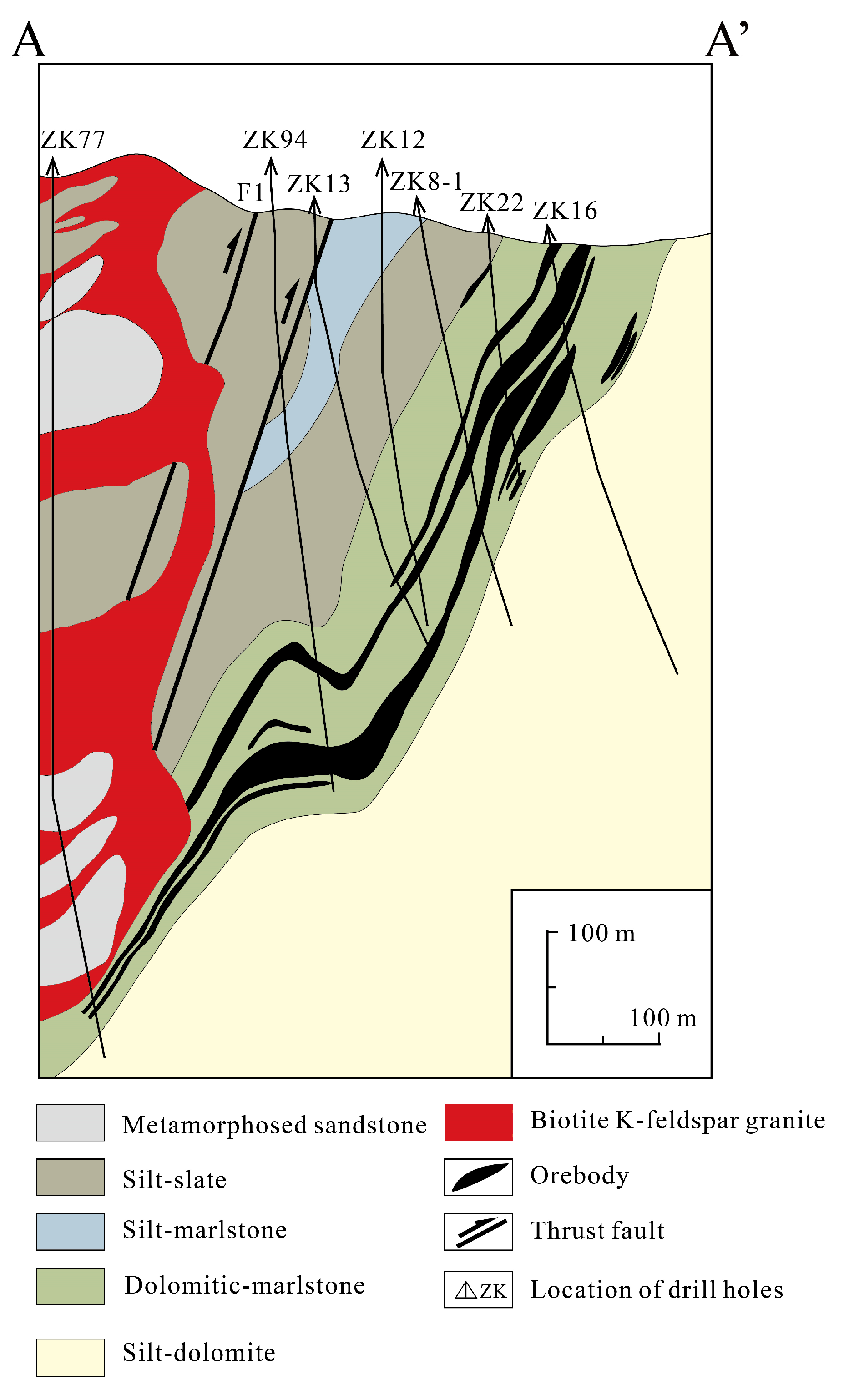
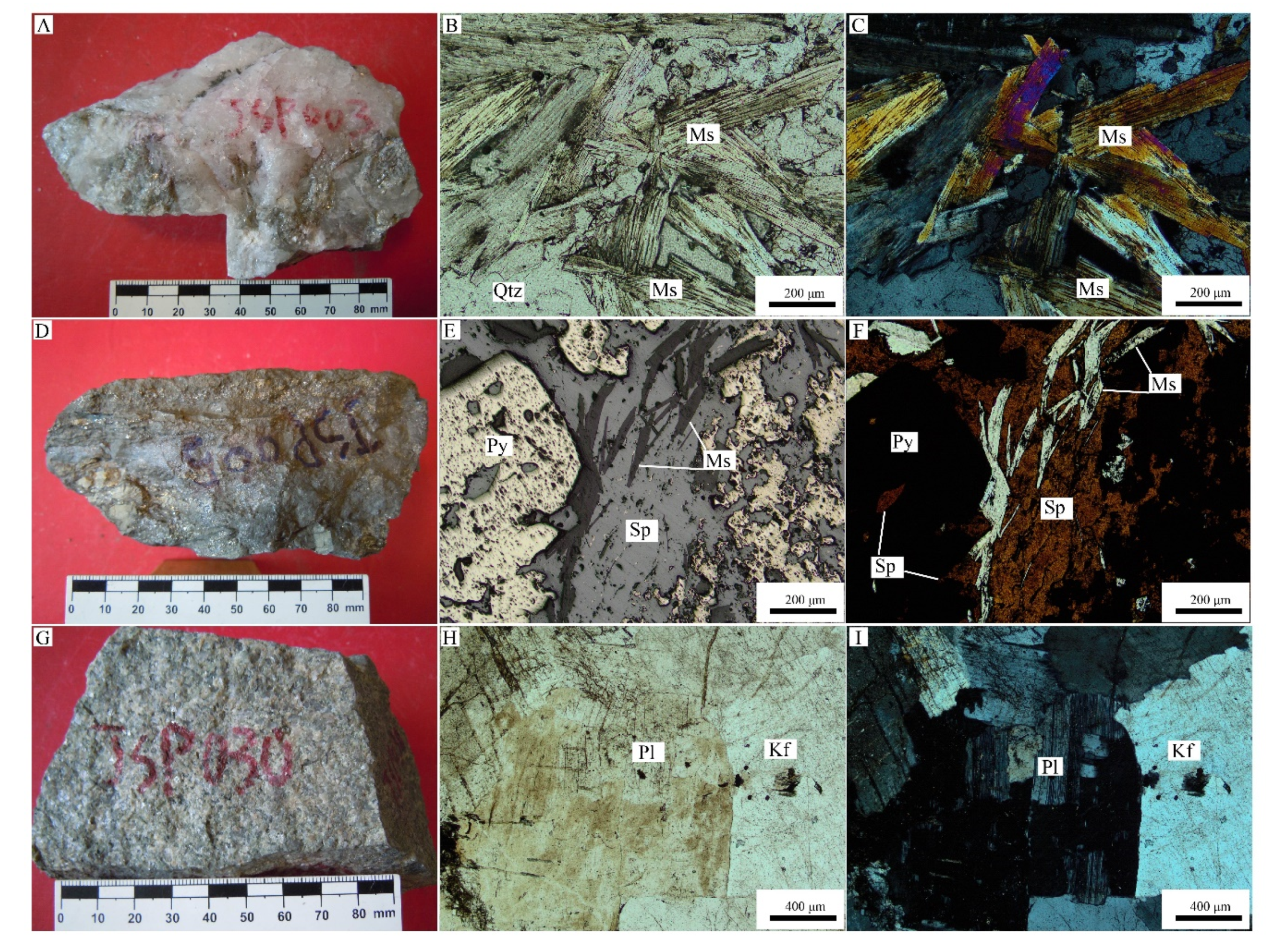
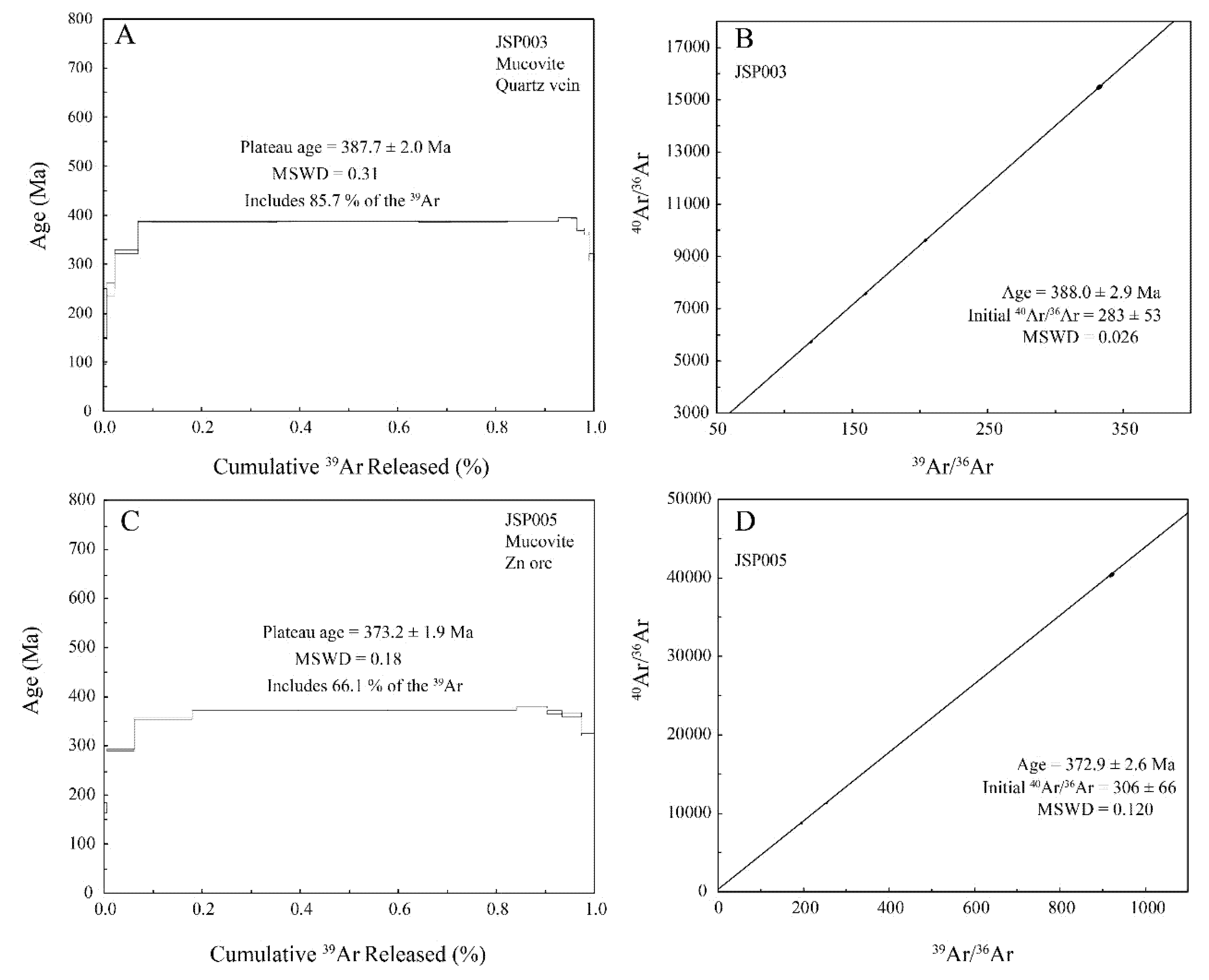
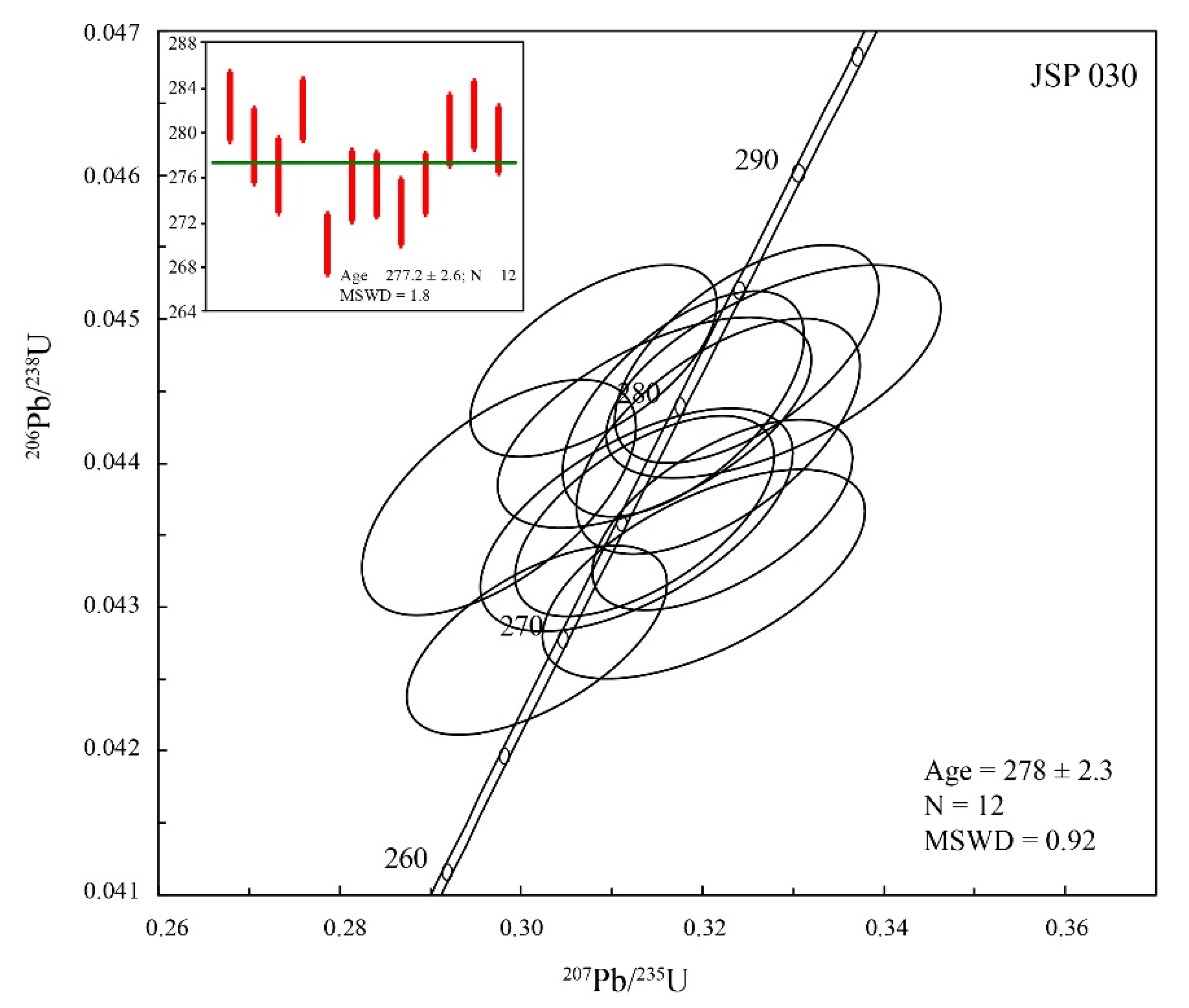
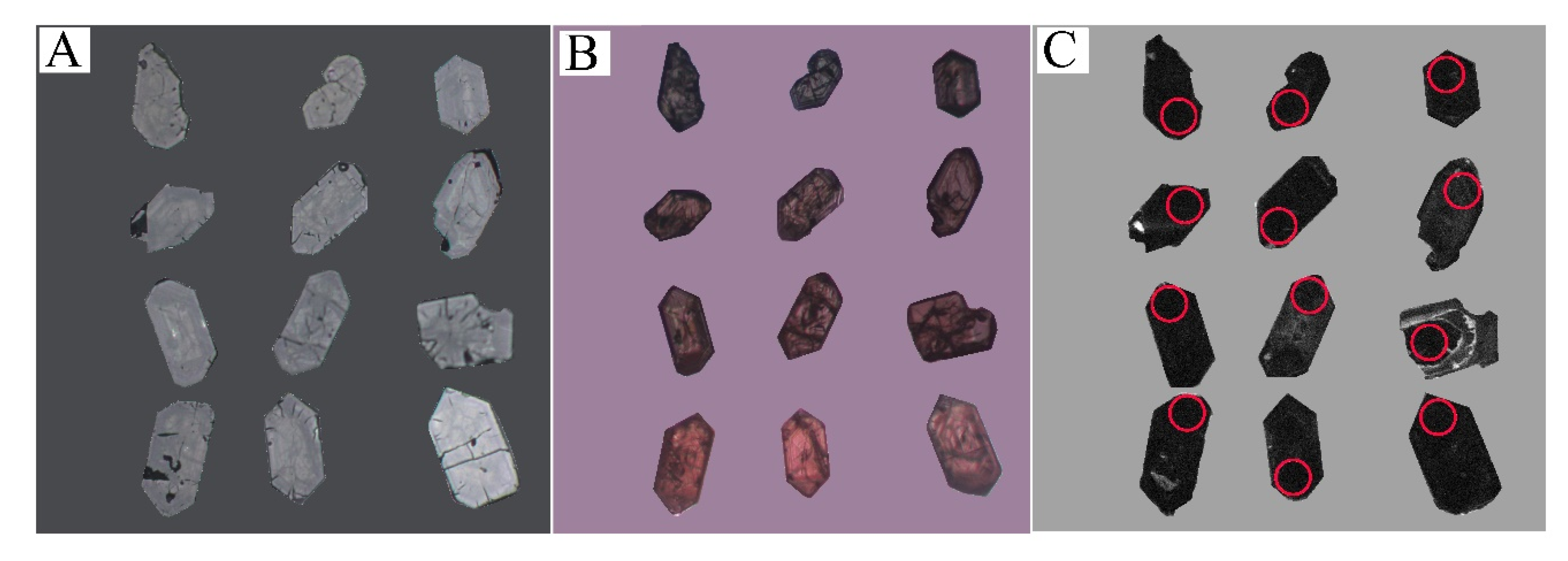
| Step | 40Ar/39Ar | 37Ar/39Ar | 36Ar/39Ar | 40Ar*/39Ar | 40Ar* (%) | Age (Ma) | ± 2σ |
|---|---|---|---|---|---|---|---|
| JSP003 J = 0.005245 | |||||||
| Step 1 | 23.9677 | 2.760084 | 0.02740485 | 16.11258 | 67.10 | 146.36 | ± 51.27 |
| Step 2 | 34.12551 | 1.679184 | 0.02029718 | 28.28611 | 82.79 | 249.56 | ± 13.20 |
| Step 3 | 42.36354 | 0.8150739 | 0.01561427 | 37.82787 | 89.24 | 326.52 | ± 3.53 |
| Step 4 | 48.12279 | 0.2661296 | 0.00833339 | 45.68248 | 94.91 | 387.50 | ± 0.96 |
| Step 5 | 46.60529 | 0.1278701 | 0.00300451 | 45.72448 | 98.10 | 387.82 | ± 0.50 |
| Step 6 | 47.49956 | 0.117464 | 0.00623654 | 45.66253 | 96.12 | 387.34 | ± 1.01 |
| Step 7 | 47.14671 | 0.1748673 | 0.0048883 | 45.71441 | 96.95 | 387.74 | ± 0.41 |
| Step 8 | 46.65878 | 0.2208983 | 0.00059775 | 46.4995 | 99.64 | 393.72 | ± 0.45 |
| Step 9 | 46.09346 | 0.5585837 | 0.00846844 | 43.64464 | 94.65 | 371.87 | ± 2.61 |
| Step 10 | 43.59298 | 1.199543 | 0.00398998 | 42.53624 | 97.49 | 363.32 | ± 2.83 |
| Step 11 | 39.86405 | 1.560482 | 0.0123677 | 36.36434 | 91.12 | 314.93 | ± 6.55 |
| JSP005 J = 0.005264 | |||||||
| Step 1 | 25.4155 | 3.873548 | 3.873548 | 19.25437 | 75.567 | 174.1679 | ± 10.78296 |
| Step 2 | 36.61591 | 0.9012945 | 0.9012945 | 33.29723 | 90.8831 | 291.3648 | ± 1.793558 |
| Step 3 | 42.81073 | 0.4183343 | 0.4183343 | 41.35762 | 96.5794 | 355.3477 | ± 0.7686522 |
| Step 4 | 43.94439 | 0.1664867 | 0.1664867 | 43.63443 | 99.2839 | 373.0172 | ± 0.8833513 |
| Step 5 | 44.85159 | 0.109381 | 0.109381 | 43.69164 | 97.4069 | 373.459 | ± 1.23016 |
| Step 6 | 45.16053 | 0.1512399 | 0.1512399 | 43.66126 | 96.6706 | 373.2244 | ± 0.6035693 |
| Step 7 | 44.95598 | 0.382604 | 0.382604 | 44.41771 | 98.778 | 379.0562 | ± 1.71614 |
| Step 8 | 44.8162 | 0.7196377 | 0.7196377 | 43.03958 | 95.9907 | 368.4174 | ± 3.699181 |
| Step 9 | 42.65749 | 0.7507671 | 0.7507671 | 42.42905 | 99.4158 | 363.6842 | ± 3.81958 |
| Step 10 | 38.1425 | 1.67781 | 1.67781 | 37.31152 | 97.7144 | 323.5136 | ± 3.241947 |
| Spot | 232Th (ppm) | 238U (ppm) | 207Pb/206Pb | 207Pb/206Pb | 207Pb/235U | 207Pb/235U | 206Pb/238U | 206Pb/238U | 207Pb/206Pb | 207Pb/206Pb | 207Pb/235U | 207Pb/235U | 206Pb/238U | 206Pb/238U |
|---|---|---|---|---|---|---|---|---|---|---|---|---|---|---|
| Ratio | 1σ | Ratio | 1σ | Ratio | 1σ | Age (Ma) | 1σ | Age (Ma) | 1σ | Age (Ma) | 1σ | |||
| JSP030-04 | 9275 | 12292 | 0.0518 | 0.0016 | 0.3249 | 0.0096 | 0.0448 | 0.0005 | 276 | 70 | 286 | 7 | 282 | 3 |
| JSP030-05 | 3808 | 7592 | 0.0520 | 0.0017 | 0.3217 | 0.0103 | 0.0442 | 0.0005 | 283 | 78 | 283 | 8 | 279 | 3 |
| JSP030-13 | 5842 | 9655 | 0.0487 | 0.0016 | 0.2975 | 0.0100 | 0.0438 | 0.0005 | 132 | 78 | 264 | 8 | 276 | 3 |
| JSP030-15 | 9054 | 12744 | 0.0494 | 0.0014 | 0.3080 | 0.0090 | 0.0447 | 0.0004 | 165 | 69 | 273 | 7 | 282 | 3 |
| JSP030-16 | 6800 | 9841 | 0.0506 | 0.0016 | 0.3017 | 0.0095 | 0.0428 | 0.0004 | 220 | 77 | 268 | 7 | 270 | 3 |
| JSP030-19 | 2186 | 5396 | 0.0514 | 0.0019 | 0.3127 | 0.0114 | 0.0436 | 0.0005 | 261 | 85 | 276 | 9 | 275 | 3 |
| JSP030-22 | 9025 | 11770 | 0.0513 | 0.0015 | 0.3136 | 0.0094 | 0.0436 | 0.0005 | 254 | 67 | 277 | 7 | 275 | 3 |
| JSP030-24 | 2707 | 5643 | 0.0528 | 0.0020 | 0.3202 | 0.0117 | 0.0432 | 0.0005 | 317 | 118 | 282 | 9 | 273 | 3 |
| JSP030-25 | 7089 | 10531 | 0.0564 | 0.0020 | 0.3429 | 0.0117 | 0.0432 | 0.0005 | 322 | 73 | 299 | 9 | 272 | 3 |
| JSP030-27 | 7576 | 11011 | 0.0527 | 0.0016 | 0.3222 | 0.0095 | 0.0436 | 0.0004 | 250 | 68 | 284 | 7 | 275 | 3 |
| JSP030-33 | 3033 | 4686 | 0.0509 | 0.0019 | 0.3147 | 0.0114 | 0.0443 | 0.0005 | 283 | 91 | 278 | 9 | 279 | 3 |
| JSP030-37 | 5891 | 9535 | 0.0520 | 0.0021 | 0.3279 | 0.0122 | 0.0446 | 0.0005 | 235 | 87 | 288 | 9 | 282 | 3 |
© 2019 by the authors. Licensee MDPI, Basel, Switzerland. This article is an open access article distributed under the terms and conditions of the Creative Commons Attribution (CC BY) license (http://creativecommons.org/licenses/by/4.0/).
Share and Cite
Yu, C.; Zhong, R.-C.; Xie, Y.-L.; Li, W.-B. Geochronological Study of the Jiashengpan Zn–Pb Deposit in Northern China: Implications for Base Metal Mineralization in Collisional Orogens. Minerals 2019, 9, 622. https://doi.org/10.3390/min9100622
Yu C, Zhong R-C, Xie Y-L, Li W-B. Geochronological Study of the Jiashengpan Zn–Pb Deposit in Northern China: Implications for Base Metal Mineralization in Collisional Orogens. Minerals. 2019; 9(10):622. https://doi.org/10.3390/min9100622
Chicago/Turabian StyleYu, Chang, Ri-Chen Zhong, Yu-Ling Xie, and Wen-Bo Li. 2019. "Geochronological Study of the Jiashengpan Zn–Pb Deposit in Northern China: Implications for Base Metal Mineralization in Collisional Orogens" Minerals 9, no. 10: 622. https://doi.org/10.3390/min9100622
APA StyleYu, C., Zhong, R.-C., Xie, Y.-L., & Li, W.-B. (2019). Geochronological Study of the Jiashengpan Zn–Pb Deposit in Northern China: Implications for Base Metal Mineralization in Collisional Orogens. Minerals, 9(10), 622. https://doi.org/10.3390/min9100622





